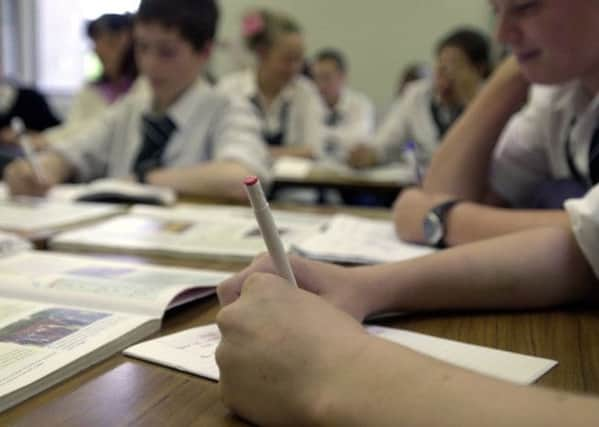North Yorkshire school league tables in full


They show the percentage of pupils across the county making expected progress in Reading, Writing and Maths is above the national average.
LEAGUE TABLES IN FULL
The government has published performance tables for every primary school. Click the links to view tables for each local authority, from the Department for Education
• LEEDS
• YORK
Advertisement
Hide AdAdvertisement
Hide AdIn total, more than 700 schools in England are now considered to be below the floor standard, the same proportion as last year, according to a Government analysis of data used to create primary school league tables.
Ministers insisted that the findings showed that schools have “raised their game”.
Schools that fail to meet the benchmark - which is based on national curriculum test results at age 11 and pupil progress throughout primary school - are considered under-performing and at risk of being turned into an academy, or taken over by a different sponsor or trust if they already have academy status.
Under the Government’s tougher standards, schools must ensure that at least 65 per cent of 11-year-olds reach level four - in reading, writing and maths, and meet national averages in pupil progress.
Advertisement
Hide AdAdvertisement
Hide AdOverall, 768 schools failed to meet the floor standard this year, compared with 767 last year, the DfE said.
In order to meet the target last year, primaries had to have 60 per cent of 11-year-olds reaching Level 4 in each of the three key areas, as well as meeting the progress goals.
York had the lowest level of primary schools below the floor - four per cent - followed by Hull, Calderdale, North Lincolnshire and Rotherham where the figure was five per cent and the East Riding where it was six per cent.
Schools Minister David Laws said: “I am pleased to see that primaries have responded to the challenge of a higher floor standard - we have raised the bar and schools have raised their game.
Advertisement
Hide AdAdvertisement
Hide Ad“It is also encouraging to see the attainment gap between disadvantaged children and their peers continue to narrow and parents, teachers and pupils deserve to be congratulated for their efforts.”
But he also warned that there are still too many areas with “simply unacceptable” levels of attainment for poorer pupils.
The Department for Education’s (DfE) analysis also shows wide variations across the country, with no schools now considered to be under-performing in some areas while in others, significant proportions are below the Government’s target. In one area alone, more than a quarter of primaries are now considered to be under the threshold.
The new rankings reveal the performance of around 16,000 primaries in national curriculum tests - known as Sats - in reading and maths, as well as teacher assessments of pupils’ writing skills.
Advertisement
Hide AdAdvertisement
Hide AdUnder the Government’s tougher standards, schools must ensure that at least 65 per cent of 11-year-olds reach Level 4 - the standard expected of the age group - in reading, writing and maths, and meet national averages in pupil progress.
Overall, 768 schools failed to meet the floor standard this year, compared with 767 last year, the DfE said.
In order to meet the target last year, primaries had to have 60 per cent of 11-year-olds reaching Level 4 in each of the three key areas, as well as meeting the progress goals.
According to the DfE’s analysis, if primary schools were judged on this year’s data against 2013’s target, only 469 schools would have fallen below the threshold.
Advertisement
Hide AdAdvertisement
Hide AdThe analysis shows that there are 22 local authorities where there are no primary schools below the government’s floor target.
These are: Blackpool, Camden, City of London, Greenwich, Haringey, Havering, Hillingdon, Hounslow, Isles of Scilly, Kingston upon Thames, Lewisham, Newham, North Tyneside, Redbridge, Richmond upon Thames, Southend-on-Sea, St Helens, Sutton, Torbay, Tower Hamlets, Westminster and Wokingham.
But at the other end of the scale, there were 13 local authorities where more than one in eight primaries are below the floor.
In Poole, more than a quarter of primaries (27 per cent) are below the standard, along with 18 per cent in both Rutland and Reading, 17 per cent in Walsall, 16 per cent in Barnsley, 15 per cent in Suffolk, Isle of Wight and and Derby, and 13 per cent in Bournemouth, Bradford, Bristol, Peterborough and Southampton.
Advertisement
Hide AdAdvertisement
Hide AdThe new statistics come the day after Ofsted chief Sir Michael Wilshaw said that primary schools in England are performing considerably better than the nation’s secondaries.
In his third annual report, he said that primaries are forging ahead, with 82 per cent rated as good or better by the watchdog and around 700,000 more pupils attending a decent primary than in 2012.
“The nation should be worried about a growing divide between primary and secondary schools,” Sir Michael said.
“In too many cases, pupils are leaving their primary schools with good literacy and numeracy skills, confident and eager to learn. But the culture they encounter at too many secondary schools often demotivates and discourages them.”
Advertisement
Hide AdAdvertisement
Hide AdAlthough primaries are outperforming secondaries nationally, Ofsted’s regional director for Yorkshire and the North East Nick Hudson has warned that Yorkshire had the lowest level of good primary schools in the country.